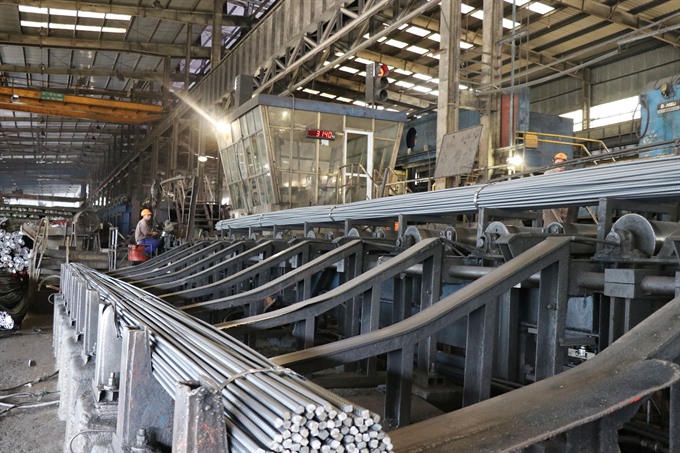 Economy
Economy

In recent months, Việt Nam’s steel industry has had to compete with a rising amount of imported steel in the domestic market and faces a number of anti-dumping investigations in export destinations, reported the Ministry of Industry and Trade.
 |
| A steel production line at the Thái Nguyên Iron and Steel JSC Co. — VNA/VNS Photo Hoàng Nguyên |
HÀ NỘI — In recent months, Việt Nam’s steel industry has had to compete with a rising amount of imported steel in the domestic market and faces a number of anti-dumping investigations in export destinations, reported the Ministry of Industry and Trade.
According to the Việt Nam Chamber of Commerce and Industry (VCCI), of the 78 anti-dumping investigations Việt Nam has encountered in the past two years, 37 cases were related to iron and steel, accounting for about 50 per cent of the goods in question.
From mid-July to early August 2018, there were eight trade defence cases initiated by other countries towards steel products imported from Việt Nam.
The Việt Nam Steel Association (VSA) warned that, as trade protectionism rises around the world, the domestic steel industry could be targeted by several markets. These lawsuits will directly affect the exportability of Vietnamese steel.
Moreover, China is restructuring its steel industry by decreasing steel output and shutting down its small, outdated and unsustainable facilities. Therefore, Chinese steel enterprises are investing in foreign countries, especially Southeast Asian countries like Indonesia and Việt Nam.
In order to deal with foreign steel, MoIT continues to maintain anti-dumping duties on H-shaped and coated steel products imported from China and the Republic of Korea to protect the domestic steel industry.
Accordingly, H-shaped steel imported from China is subject to a tax rate of 20.48 to 29.4 per cent.
For galvanised steel products, Chinese coated steel exporters are subject to a tax rate of 3.17-38.34 per cent and the Republic of Korea 7.02-19 per cent.
Potential domestic market
The MoIT said that the domestic construction steel market in October was quiet due to unfavourable weather. In addition, steel consumption for projects is also slow as most projects are in their completion phase, with few new projects breaking ground.
Due to the slow consumption, a number of steel producers in the north have introduced discount programmes. As a result, prices in the northern market decreased by VNĐ100,000-VNĐ150,000 (US$4.27-$6.41) per tonne compared to the previous month, depending on the product category. Meanwhile, prices in the southern market are relatively stable and supply is guaranteed.
Nguyễn Văn Sưa, vice chairman and secretary of the VSA, estimated that in the domestic market, the production and sale of steel still has a high rate of growth and is expected to maintain an upward trend towards the end of the year.
“Despite the heavy rain in October affecting the construction of buildings, steel consumption in the country is still strong. This proves that Vietnamese steel products are very competitive in the domestic market," he said.
In the first 10 months of 2018, Việt Nam produced over 20 million tonnes of steel, up 17.7 per cent over the same period in 2017. The sale of steel reached over 18 million tonnes, a year-on-year increase of 27.7 per cent; of which, exports reached over 3.9 million tonnes, up 31.6 per cent against the same period last year.
Making recommendations for the domestic steel industry, Sưa suggested that enterprises need to analyse the market needs to choose an investment plan. First of all, enterprises have to choose the types of steel which are most commonly used.
As well as supporting enterprises in anti-dumping investigations, the MoIT also recommends that steel companies improve their competitiveness and control of domestic raw materials. — VNS




